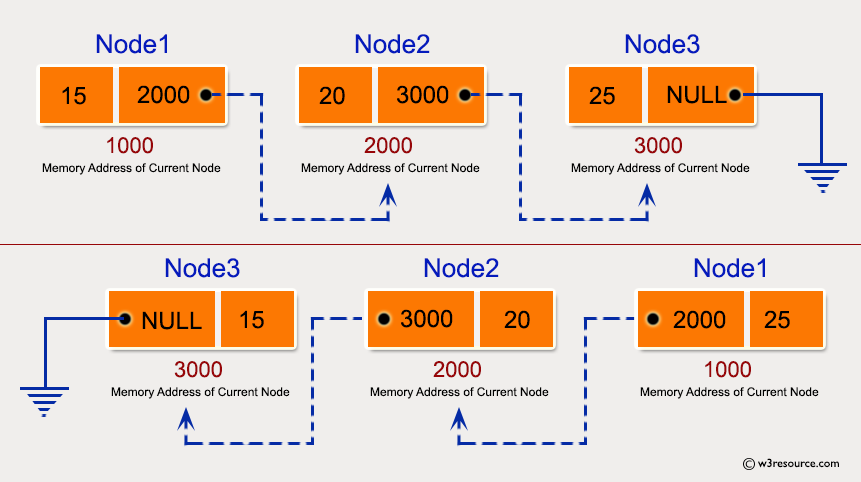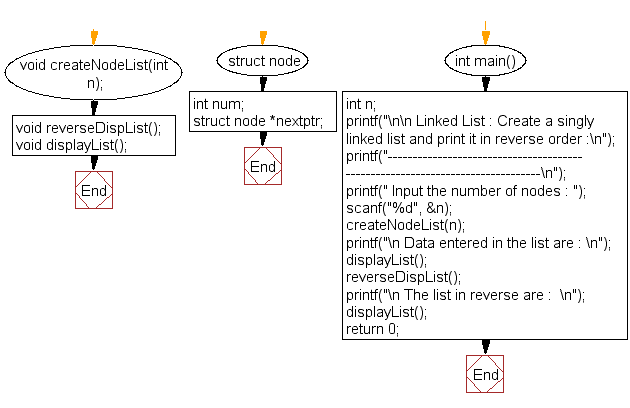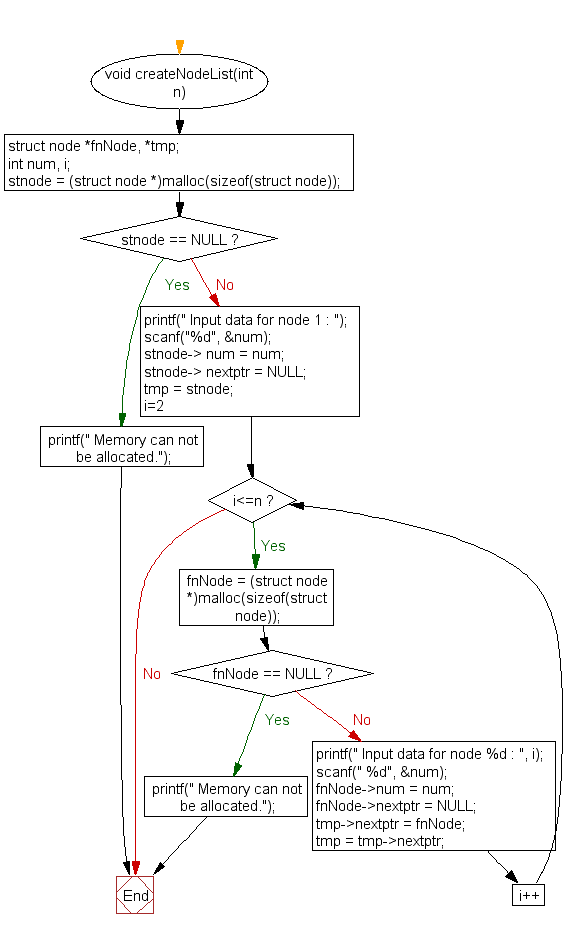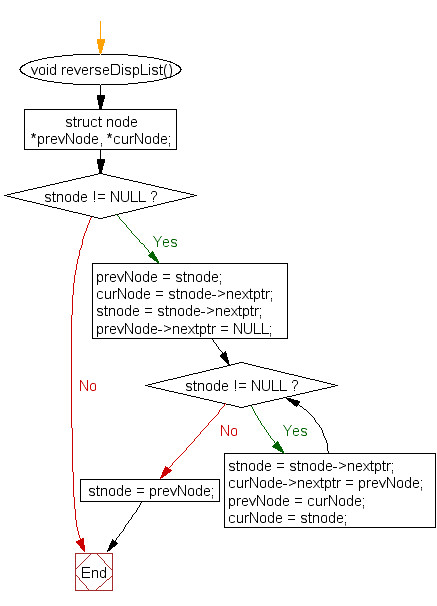
Упражнения C: Создайте односвязный список и распечатайте его в обратном порядке.
C связанный список: упражнение 2 с решением
Напишите программу на C, чтобы создать односвязный список из n узлов и отобразить его в обратном порядке.
Иллюстрированная презентация:

Пример решения:
Код C:
#include <stdio.h>
#include <stdlib.h>
struct node
{
int num; //Data of the node
struct node *nextptr; //Address of the node
}*stnode;
void createNodeList(int n); //function to create the list
void reverseDispList(); //function to convert the list in reverse
void displayList(); //function to display the list
int main()
{
int n;
printf("\n\n Linked List : Create a singly linked list and print it in reverse order :\n");
printf("------------------------------------------------------------------------------\n");
printf(" Input the number of nodes : ");
scanf("%d", &n);
createNodeList(n);
printf("\n Data entered in the list are : \n");
displayList();
reverseDispList();
printf("\n The list in reverse are : \n");
displayList();
return 0;
}
void createNodeList(int n)
{
struct node *fnNode, *tmp;
int num, i;
stnode = (struct node *)malloc(sizeof(struct node));
if(stnode == NULL) //check whether the stnode is NULL and if so no memory allocation
{
printf(" Memory can not be allocated.");
}
else
{
// reads data for the node through keyboard
printf(" Input data for node 1 : ");
scanf("%d", &num);
stnode-> num = num;
stnode-> nextptr = NULL; //Links the address field to NULL
tmp = stnode;
//Creates n nodes and adds to linked list
for(i=2; i<=n; i++)
{
fnNode = (struct node *)malloc(sizeof(struct node));
if(fnNode == NULL) //check whether the fnnode is NULL and if so no memory allocation
{
printf(" Memory can not be allocated.");
break;
}
else
{
printf(" Input data for node %d : ", i);
scanf(" %d", &num);
fnNode->num = num; // links the num field of fnNode with num
fnNode->nextptr = NULL; // links the address field of fnNode with NULL
tmp->nextptr = fnNode; // links previous node i.e. tmp to the fnNode
tmp = tmp->nextptr;
}
}
}
}
void reverseDispList()
{
struct node *prevNode, *curNode;
if(stnode != NULL)
{
prevNode = stnode;
curNode = stnode->nextptr;
stnode = stnode->nextptr;
prevNode->nextptr = NULL; //convert the first node as last
while(stnode != NULL)
{
stnode = stnode->nextptr;
curNode->nextptr = prevNode;
prevNode = curNode;
curNode = stnode;
}
stnode = prevNode; //convert the last node as head
}
}
void displayList()
{
struct node *tmp;
if(stnode == NULL)
{
printf(" No data found in the list.");
}
else
{
tmp = stnode;
while(tmp != NULL)
{
printf(" Data = %d\n", tmp->num); // prints the data of current node
tmp = tmp->nextptr; // advances the position of current node
}
}
}
Пример вывода:
Связанный список: создайте односвязный список и распечатайте его в обратном порядке:
-------------------------------------------------- ----------------------------
Введите количество узлов: 3
Входные данные для узла 1: 5
Входные данные для узла 2: 6
Входные данные для узла 3: 7
Данные, введенные в список:
Данные = 5
Данные = 6
Данные = 7
Список в обратном порядке:
Данные = 7
Данные = 6
Данные = 5
Блок - схема:

createNodeList ():

reverseDispList ():

displayList ():

Редактор кода программирования C:
Есть другой способ решить это решение? Внесите свой код (и комментарии) через Disqus.
Предыдущий: Напишите программу на C для создания и отображения Единственного связанного списка.
Далее: Напишите программу на C, чтобы создать односвязный список из n узлов и подсчитать количество узлов.
Каков уровень сложности этого упражнения?
Новый контент: Composer: менеджер зависимостей для PHP , R программирования
disqus2code